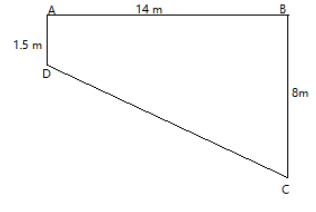
The cross-section \[ABCD\] of a swimming pool is a trapezium. It's width \[AB = 14{\text{m}}\] depth at the shallow end is 1.5 m and at the deep end is 8 m. Find the area of the cross-section.


Answer
582.3k+ views
Hint: Construct the line \[DE\] perpendicular to the line \[BC\]. Find the area of the triangle \[DCE\] using the formula \[\dfrac{1}{2} \times base \times height\]. Find the area of the rectangle \[DABE\] using the formula \[Base \times height\]. Add the two to find the answer.
Complete step-by-step answer:
We will first construct the line \[DE\] perpendicular to the line \[BC\]. \[E\] is the intersection point of \[BC\]and $DE$, such that $BC \bot DE$

We know that the area of the triangle is \[\dfrac{1}{2} \times base \times height\]. In the triangle \[DCE\], the area can be calculated by substituting \[DE\] for base and \[CE\].
\[\dfrac{1}{2} \times CE \times DE\]
From the figure it is evident that, \[DE = AB = 14{\text{m}}\] and, \[CE + EB = {\text{ }}8{\text{m}}\]. Also, \[AD = EB = 1.5{\text{m}}\]
Therefore \[CE = 8 - 1.5 = 6.5{\text{m}}\].
Substituting the value 6.5 for \[CE\] and 14 for \[DE\] in the equation \[\dfrac{1}{2} \times CE \times DE\].
Thus, area of the triangle \[DCE\] = \[\dfrac{1}{2} \times 6.5 \times 14 = 45.5{{\text{m}}^3}\]
Also, the area of the rectangle is given by the formula \[Base \times height\].
Substituting the value of base with \[AB\] and \[AD\] for height in the formula \[Base \times height\] to find the area of the rectangle \[ABED\].
Area of \[ABED\]=\[AB \times AD\].
Substituting the value 14 for \[AB\] and 1.5 for \[AD\], we get
Area of \[ABED\]= \[14 \times 1.5 = 21\]
The area of the cross-section \[ABCD\] is equal to the sum of the section \[ABED\] and section \[DCE\].
Area of \[ABCD\]= Area of \[ABED\]+ Area of \[DCE\].
Area of \[ABCD\]= $45.5 + 21 = 66.5{{\text{m}}^3}$
Thus the area of the cross section \[ABCD\] is \[66.5{{\text{m}}^3}\].
Note: The formula of the area of the trapezium can also be used alternatively. The area of the trapezium is given by \[\dfrac{1}{2} \times \left( {sum{\text{ }}of{\text{ }}the{\text{ }}parallel{\text{ }}sides} \right) \times {\text{ }}height{\text{ }}between{\text{ }}the{\text{ }}parallel{\text{ }}sides\].
Complete step-by-step answer:
We will first construct the line \[DE\] perpendicular to the line \[BC\]. \[E\] is the intersection point of \[BC\]and $DE$, such that $BC \bot DE$

We know that the area of the triangle is \[\dfrac{1}{2} \times base \times height\]. In the triangle \[DCE\], the area can be calculated by substituting \[DE\] for base and \[CE\].
\[\dfrac{1}{2} \times CE \times DE\]
From the figure it is evident that, \[DE = AB = 14{\text{m}}\] and, \[CE + EB = {\text{ }}8{\text{m}}\]. Also, \[AD = EB = 1.5{\text{m}}\]
Therefore \[CE = 8 - 1.5 = 6.5{\text{m}}\].
Substituting the value 6.5 for \[CE\] and 14 for \[DE\] in the equation \[\dfrac{1}{2} \times CE \times DE\].
Thus, area of the triangle \[DCE\] = \[\dfrac{1}{2} \times 6.5 \times 14 = 45.5{{\text{m}}^3}\]
Also, the area of the rectangle is given by the formula \[Base \times height\].
Substituting the value of base with \[AB\] and \[AD\] for height in the formula \[Base \times height\] to find the area of the rectangle \[ABED\].
Area of \[ABED\]=\[AB \times AD\].
Substituting the value 14 for \[AB\] and 1.5 for \[AD\], we get
Area of \[ABED\]= \[14 \times 1.5 = 21\]
The area of the cross-section \[ABCD\] is equal to the sum of the section \[ABED\] and section \[DCE\].
Area of \[ABCD\]= Area of \[ABED\]+ Area of \[DCE\].
Area of \[ABCD\]= $45.5 + 21 = 66.5{{\text{m}}^3}$
Thus the area of the cross section \[ABCD\] is \[66.5{{\text{m}}^3}\].
Note: The formula of the area of the trapezium can also be used alternatively. The area of the trapezium is given by \[\dfrac{1}{2} \times \left( {sum{\text{ }}of{\text{ }}the{\text{ }}parallel{\text{ }}sides} \right) \times {\text{ }}height{\text{ }}between{\text{ }}the{\text{ }}parallel{\text{ }}sides\].
Recently Updated Pages
Master Class 9 Social Science: Engaging Questions & Answers for Success

Master Class 9 Science: Engaging Questions & Answers for Success

Master Class 9 English: Engaging Questions & Answers for Success

Master Class 9 Maths: Engaging Questions & Answers for Success

Master Class 11 Economics: Engaging Questions & Answers for Success

Master Class 11 English: Engaging Questions & Answers for Success

Trending doubts
Which places in India experience sunrise first and class 9 social science CBSE

Fill the blanks with the suitable prepositions 1 The class 9 english CBSE

Write the 6 fundamental rights of India and explain in detail

Difference Between Plant Cell and Animal Cell

What is the Full Form of ISI and RAW

Golden Revolution is related to AFood production BOil class 9 social science CBSE




